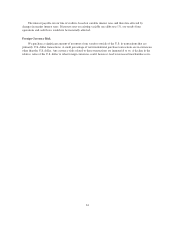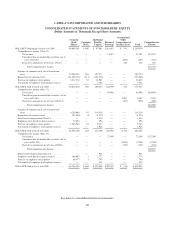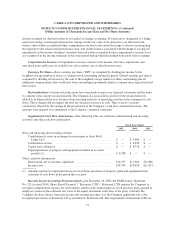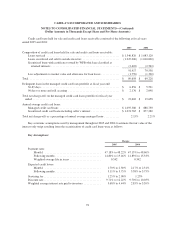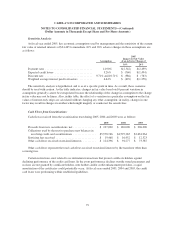Cabela's 2005 Annual Report Download - page 83
Download and view the complete annual report
Please find page 83 of the 2005 Cabela's annual report below. You can navigate through the pages in the report by either clicking on the pages listed below, or by using the keyword search tool below to find specific information within the annual report.CABELA’S INCORPORATED AND SUBSIDIARIES
NOTES TO CONSOLIDATED FINANCIAL STATEMENTS—(Continued)
(Dollar Amounts in Thousands Except Share and Per Share Amounts)
Store Preopening Expenses—Non-capital costs associated with the opening of new stores are expensed as
incurred.
Property and Equipment—Property and equipment are stated at cost. Depreciation and amortization are
provided for in amounts sufficient to relate the cost of depreciable assets to operations over their estimated
service lives. Leasehold improvements are amortized over the lives of the respective leases or the service lives of
the improvements whichever is shorter. The straight-line method of depreciation is used for financial reporting.
Assets held under capital lease agreements are amortized using the straight-line method over the shorter of the
estimated useful lives of the assets or the lease term. Major improvements that extend the useful life of an asset
are charged to the property and equipment accounts. Routine maintenance and repairs are charged against
earnings. The cost of property and equipment retired or sold and the related accumulated depreciation are
removed from the accounts and any related gain or loss is included in earnings. Long-lived assets used by the
Company are reviewed for impairment whenever events or changes in circumstances indicate that the carrying
amount of an asset may not be recoverable. The Company capitalizes interest costs on construction of projects
while they are being constructed and before they are placed into service. For the fiscal years ended 2005, 2004
and 2003, the Company capitalized $371, $0 and $246 of interest costs.
The Company follows the American Institute of Certified Public Accountants Statement of Position
(“SOP”) No. 98-1, Accounting for the Cost of Computer Software Developed or Obtained for Internal Use.In
accordance with SOP No. 98-1, the Company capitalizes all costs related to internally developed or purchased
software and amortizes these costs on a straight-line basis over their estimated useful lives.
Intangible Assets—Intangible assets consist of purchased credit card relationships, deferred financing costs,
non-compete agreements and goodwill. Purchased credit card relationships represent the intangible value of
acquired credit card relationships. Recorded goodwill is tested annually for impairment by comparing the fair
value of the Company’s reporting units to their carrying value. The Company performed its annual goodwill
impairment test in the fourth quarter of fiscal 2005 and 2004. Fair value was determined using a discounted cash
flow methodology. There were no impairment adjustments for fiscal years 2005 and 2004.
Marketable Securities—Economic development bonds (“bonds”) issued by state and local municipalities
that management has the positive intent and ability to hold to maturity are classified as “held-to-maturity” and
recorded at amortized cost. WFB holds mortgage backed securities from the Nebraska Investment Finance
Authority (NIFA), which are classified as “held-to-maturity” and recorded at amortized cost. For bonds classified
as available-for-sale where quoted market prices are not available, fair values are estimated using present value
or other valuation techniques. The fair value estimates are made at a specific point in time, based on available
market information and judgments about the bonds, such as estimates of timing and amount of expected future
cash flows. Such estimates do not reflect any premium or discount that could result from offering for sale at one
time the Company’s entire holdings of a particular bond, nor do they consider the tax impact of the realization of
unrealized gains or losses.
Declines in the fair value of held-to-maturity and available-for-sale bonds and securities below cost that are
deemed to be other than temporary are reflected in earnings as realized losses. Gains and losses on the sale of
securities are recorded on the trade date and determined using the specific identification method.
Investment in Equity and Cost Method Investees—Companies that are 50% or less owned by the Company
have been excluded from consolidation. The Company reflects its 33% investment in Three Corners LLC at cost
plus its equity in undistributed net earnings or losses since acquisition reduced by dividends. Dividends received
from Three Corners L.L.C. were $583, $150 and $0 for the fiscal years ended 2005, 2004 and 2003, respectively.
71


